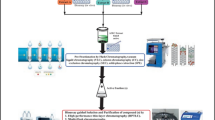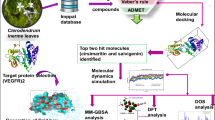Abstract
Withania somnifera L. has been traditionally used as a sedative and hypnotic. The present study was carried out for the purification, characterization, and in vitro cytotoxicity of l-asparaginase from W. somnifera L. l-Asparaginase was purified from the fruits of W. somnifera L. up to 95% through chromatography. The purified l-asparaginase was characterized by size exclusion chromatography, polyacrylamide gel electrophoresis (PAGE), and 2D PAGE. The antitumor and growth inhibition effect of the l-asparaginase was assessed using [3-(4, 5-dimethyl-thiazol-2yl)-2, 5-diphenyl-tetrazolium bromide] (MTT) colorimetric dye reduction method. The purified enzyme is a homodimer, with a molecular mass of 72 ± 0.5 kDa, and the pI value of the enzyme was around 5.1. This is the first report of the plant containing l-asparaginase with antitumor activity. Data obtained from the MTT assay showed a LD50 value of 1.45 ± 0.05 IU/ml. W. somnifera L. proved to be an effective and a novel source of l-asparaginase. Furthermore, it shows a lot of similarity with bacterial l-asparaginases EC-2.



Similar content being viewed by others
References
Ichikawa, H., Takada, Y., Shishodia, S., Jayaprakasam, B., Nair, M. G., & Aggarwal, B. B. (2006). Molecular Cancer Therapeutics, 5(6), 1434–1445. doi:10.1158/1535-7163.MCT-06-0096.
Cammack, K., & Marlborough, D. (1972). Biochemistry Journal, 126, 361.
Borek, D., & Jaskolski, M. (2001). Sequence analysis of enzymes with asparaginase activity. Acta Biochimica Polonica, 48, 893–902.
Ortlund, E., Lacount, M. W., Lewinski, K., & Lebioda, L. (2000). Biochemistry, 39, 1199–1204. doi:10.1021/bi991797d.
Bonthron, D. T., & Jaskolski, M. (1997). Acta Biochimica Polonica, 44, 491–504.
Sugimoto, H., Odani, S., & Yamashita, S. (1998). Journal of Biological Chemistry, 273, 12536–12542. doi:10.1074/jbc.273.20.12536.
Tumbula, D. L., Becker, H. D., Chang, W. Z., & Soll, D. (2000). Nature, 407, 106–110. doi:10.1038/35024120.
Lubkowski, J., Dauter, M., Aghaiypour, K., Wlodawer, A., & Dauter, Z. (2003). Acta Crystallographica D, 59, 84–92. doi:10.1107/S0907444902019443.
Lee, B., & Yang, H. (1973). Journal of Biological Chemistry, 248, 7620.
Jones, P., Kristiansen, T., & Einarsson, M. (1973). Biochimica et Biophysica Acta, 327, 146.
Whelan, H., & Wriston, J. (1974). Biochimica et Biophysica Acta, 365, 212.
Soru, E., Teodorescu, M., Zaharia, O., Szabados, J., & Rudescu, K. (1972). Canadian Journal of Biochemistry, 50, 1149. doi:10.1139/v72-182.
DeJong, P. (1972). Applied Microbiology, 23, 1163.
Roberts, J., Holcenberg, J., & Dolowy, W. (1972). Journal of Biological Chemistry, 247, 84.
Mathews, W., & Brown, H. (1974). Enzyme, 17, 276.
Siechiechowicz, K., & Ireland, R. (1989). Phytochemistry, 28, 2275. doi:10.1016/S0031-9422(00)97967-6.
Lough, T. J., Reddington, B. D., Grant, M. R., Hill, D. F., Reynolds, P. H. S., & Farnden, K. J. F. (1992). Plant Molecular Biology, 19, 391–399. doi:10.1007/BF00023386.
Bruneau, L., Chapman, R., & Marsolais, F. (2006). Planta, 224, 668–679. doi:10.1007/s00425-006-0245-9.
Sodek, L., Lea, P. J., & Miflin, D. J. (1980). Plant Physiology, 65, 22–26. doi:10.1104/pp.65.1.22.
Sieciechowicz, K. A., Joy, K. W., & Ireland, R. J. (1988). Phytochemistry, 27, 663–671. doi:10.1016/0031-9422(88)84071-8.
Laemmli, U. (1970). Nature, 227, 680–685. doi:10.1038/227680a0.
Blum, H., & Gross, H. J. (1987). Electrophoresis, 8, 93–99. doi:10.1002/elps.1150080203.
Moriji, M., Masami, M., Kumi, K., Akimitsu, M., Tadaaki, U., & Kazumasa, Y. (1970). Cancer Research, 30, 768–772.
Carmichael, J., DeGraff, W. G., & Gazdar, A. F. (1987). Cancer Research, 47, 936–942.
Mosmann, T. (1983). Journal of Immunological Methods, 65, 55–63. doi:10.1016/0022-1759(83)90303-4.
Lea, P. J., Festenstein, G. N., Hughes, G. R., & Miflin, B. J. (1984). Phytochemistry, 23, 511–514. doi:10.1016/S0031-9422(00)80369-6.
Mozeena, B. V., & Sivaramakrisnan. (1980). Journal of Biosciences, 2, 291–297. doi:10.1007/BF02716861.
Author information
Authors and Affiliations
Corresponding author
Rights and permissions
About this article
Cite this article
Oza, V.P., Parmar, P.P., Kumar, S. et al. Anticancer Properties of Highly Purified l-Asparaginase from Withania somnifera L. against Acute Lymphoblastic Leukemia. Appl Biochem Biotechnol 160, 1833–1840 (2010). https://doi.org/10.1007/s12010-009-8667-z
Received:
Accepted:
Published:
Issue Date:
DOI: https://doi.org/10.1007/s12010-009-8667-z




